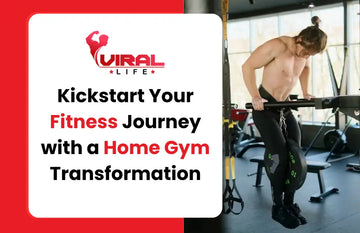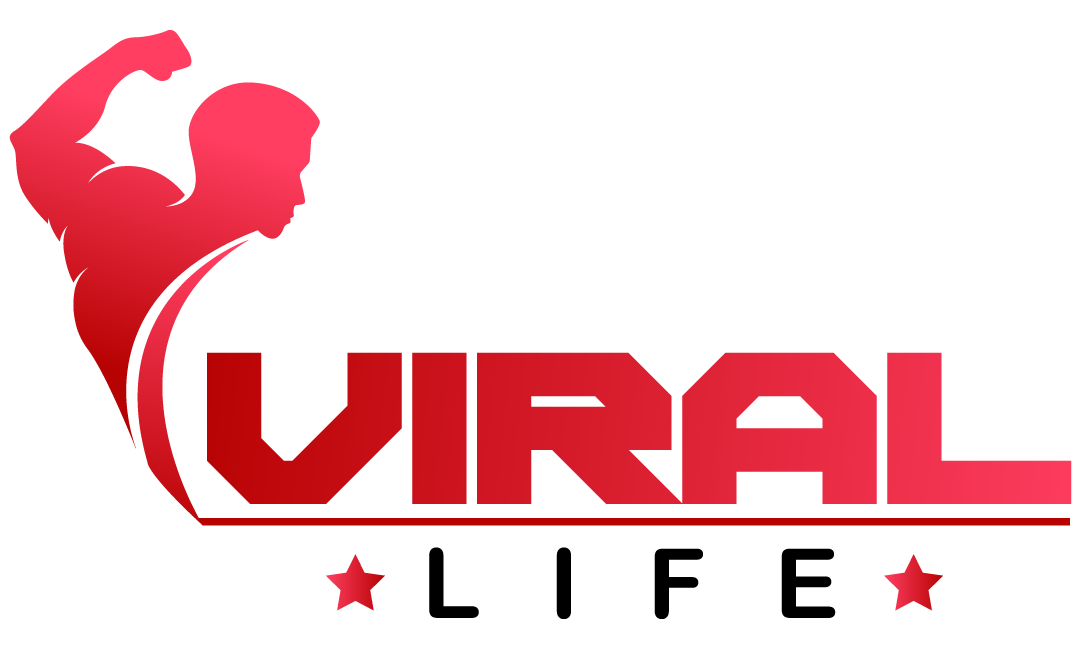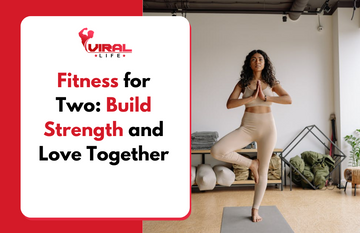Kickstart Your Fitness Journey with a Home Gym Transformation
by Felipe Freitas on Oct 21, 2024

Starting a fitness journey can feel overwhelming, but it doesn’t have to be! If you’re looking for an accessible and effective way to get in shape, kickstart your fitness journey with a home gym transformation. In this guide, we’ll explore how to build a home gym, why it can revolutionize your fitness routine, and how to maximize your space and equipment to achieve lasting results. Whether you're a beginner or a seasoned athlete, creating a home gym will allow you to take control of your health and fitness on your own terms.
Essential Equipment for a Home Gym
| Equipment | Function | Price Range | Space Needed | Beginner Friendly | Versatility | Benefits | Portable? | Durability | Maintenance |
|---|---|---|---|---|---|---|---|---|---|
| Dumbbells | Strength Training | $20 - $150 | Minimal | Yes | High | Builds muscle and tones body | Yes | High | Low |
| Kettlebells | Strength/Cardio Combo | $30 - $100 | Minimal | Yes | High | Improves strength and cardio endurance | Yes | High | Low |
| Resistance Bands | Flexibility & Strength | $10 - $40 | Minimal | Yes | High | Adds resistance to various exercises | Yes | High | Low |
| Yoga Mat | Stretching, Core, Stability | $15 - $50 | Minimal | Yes | High | Essential for floor exercises | Yes | High | Low |
| Treadmill (optional) | Cardio Training | $500 - $2,000 | Moderate | Yes | Low | Excellent for cardio and endurance | No | High | Moderate |
| Adjustable Bench | Strength Training | $80 - $200 | Minimal | Yes | Medium | Supports various strength exercises | No | High | Low |
| Pull-up Bar | Strength Training | $20 - $50 | Minimal | Yes | Low | Builds upper body strength | Yes | High | Low |
| Jump Rope | Cardio Training | $10 - $30 | Minimal | Yes | Medium | Excellent for cardio and coordination | Yes | High | Low |
| Medicine Ball | Core & Strength Training | $20 - $60 | Minimal | Yes | High | Improves strength, balance, and power | Yes | High | Low |
| Rowing Machine (optional) | Cardio and Full Body Workout | $300 - $1,500 | Moderate | Yes | Low | Provides an excellent full-body workout | No | High | Moderate |
Why a Home Gym is the Ultimate Fitness Solution
In today’s busy world, finding time to hit the gym regularly can be a challenge. Between work, family commitments, and social life, squeezing in an hour at a crowded fitness center may feel impossible. That’s where transforming your home into a gym can make all the difference.
The Flexibility of a Home Gym
Imagine having 24/7 access to your gym, with no commute and no waiting for machines. When you kickstart your fitness journey with a home gym transformation, you have the flexibility to work out whenever it suits you. Morning routines, lunchtime sweats, or late-night lifts are all on your schedule.
Flexibility is key to consistency, and as we know, consistency is what delivers real results. No more excuses about traffic, bad weather, or gym hours—your gym is always open.
The Financial Benefits of a Home Gym
Let’s talk about another important factor—cost. Gym memberships can be expensive, especially when you factor in additional costs like gas, parking, or babysitting. Over time, investing in home gym equipment can save you money, and the best part? You get to design a space that’s tailored exactly to your preferences and fitness goals.
Budgeting for Your Home Gym
One of the biggest misconceptions about home gyms is that they are costly to set up. However, you don’t need to spend thousands of dollars to get started. Begin with a few key pieces of equipment, such as dumbbells, a yoga mat, and resistance bands. As you progress, you can expand your home gym, adding items like a weight bench, pull-up bar, or even a treadmill, all while staying within your budget.
Creating the Perfect Space for Your Home Gym
Finding the right space in your home is the first step to building a gym. Whether you have a spare room, garage, basement, or even a small corner of your living room, you can design a gym that works for you.
Maximizing Small Spaces
Don't worry if you're limited on space. Even a 5x5-foot area can become your personal fitness zone with creative use of storage and versatile equipment. Opt for foldable or stackable items, such as collapsible benches or stackable dumbbells, to keep the area tidy when not in use. Multi-functional equipment like adjustable dumbbells or a pull-up bar that fits over a doorway can help you maximize a small area.
Must-Have Equipment to Kickstart Your Fitness Journey
While you can go all-out and purchase everything from treadmills to squat racks, it’s not necessary to start. To truly kickstart your fitness journey with a home gym transformation, you’ll need just a few essentials that can provide a full-body workout. Here’s a breakdown of the must-have equipment:
1. Dumbbells and Kettlebells
These versatile tools can be used for strength training, toning, and even cardio-based workouts. Whether you’re lifting heavy or light, dumbbells and kettlebells are excellent for building muscle and increasing endurance.
2. Resistance Bands
Perfect for beginners or advanced athletes, resistance bands add variety and challenge to your routine. They can be used for everything from strength training to stretching.
3. Yoga Mat
A yoga mat is essential not only for yoga or Pilates but also for core exercises, stretching, and floor-based strength moves. It's a budget-friendly, versatile piece of equipment that can travel with you.
4. Cardio Machines (Optional)
If space and budget allow, adding a treadmill, stationary bike, or rowing machine can provide excellent cardio training. However, bodyweight exercises and circuit routines can be just as effective without machines.
Tailoring Your Workouts for Success
Now that your home gym is set up, it’s time to create a workout plan that aligns with your goals. The beauty of a home gym is that it can cater to any fitness level. Whether you’re working toward weight loss, strength gains, or improving flexibility, a structured plan will keep you on track.
Full-Body Strength Routine
Strength training is essential for burning fat and building lean muscle. Start with compound movements like squats, deadlifts, and push-ups to target multiple muscle groups simultaneously. Using dumbbells or resistance bands, incorporate exercises like rows, chest presses, and lunges for a full-body workout.
Cardio Intervals
Cardio doesn’t have to mean endless hours on a treadmill. High-intensity interval training (HIIT) is a time-efficient way to burn calories and improve cardiovascular health. You can design your HIIT circuit using bodyweight exercises, such as jump squats, burpees, and mountain climbers, or incorporate your kettlebells and resistance bands for added intensity.
Overcoming Common Challenges
When you’re setting up a home gym and starting your fitness journey, challenges will arise. It’s normal to hit roadblocks like motivation dips, equipment issues, or time constraints. Here are some practical ways to overcome them:
Staying Motivated at Home
Without the atmosphere of a gym, it’s easy to lose motivation. To combat this, set specific goals—whether it's a certain number of workouts per week or aiming for a fitness milestone, like running a 5K. You can also track your progress using apps or a fitness journal.
Accountability Partners
Even though you're working out at home, you don't have to go it alone. Connect with a friend or fitness group online, share your progress, and hold each other accountable. If possible, arrange to work out with a partner in person for extra encouragement.
Real-Life Success Stories
There are countless examples of people who have transformed their fitness journeys by setting up a home gym. Take Sarah, for instance, who found herself unable to make it to the gym after the birth of her first child. With a small investment in resistance bands and dumbbells, she began working out in her living room while her baby napped. After six months, Sarah not only lost the baby weight but also felt stronger and healthier than ever.
Another success story is James, who struggled with motivation to get to the gym after long workdays. By creating a compact home gym in his garage, James could squeeze in a quick workout before dinner, helping him regain his fitness and shed the extra pounds from years of sedentary living.
Conclusion: Take Control of Your Fitness with a Home Gym
To sum it up, if you’re ready to take control of your health and fitness, there’s no better way than to kickstart your fitness journey with a home gym transformation. By creating a personalized space that fits your budget, lifestyle, and goals, you’ll be set up for long-term success. No more excuses—your fitness journey starts now, right in the comfort of your own home.
FAQs About Home Gym Transformation
Q: How much does it cost to build a home gym?
A: The cost of a home gym varies depending on the equipment you choose. Basic setups can start as low as $100, while more advanced setups with machines can go up to $1,000 or more.
Q: Do I need a lot of space for a home gym?
A: No! You can create a functional home gym in as little as 5x5 feet by using compact and multi-functional equipment.
Q: What equipment should I start with?
A: Dumbbells, resistance bands, and a yoga mat are essential for strength, flexibility, and cardio-based workouts.
Q: Can I get a full workout without machines?
A: Absolutely. Bodyweight exercises, resistance bands, and dumbbells offer full-body workouts without the need for large machines.
Q: How do I stay motivated when working out at home?
A: Set specific fitness goals, track your progress, and consider partnering with a workout buddy for accountability.



